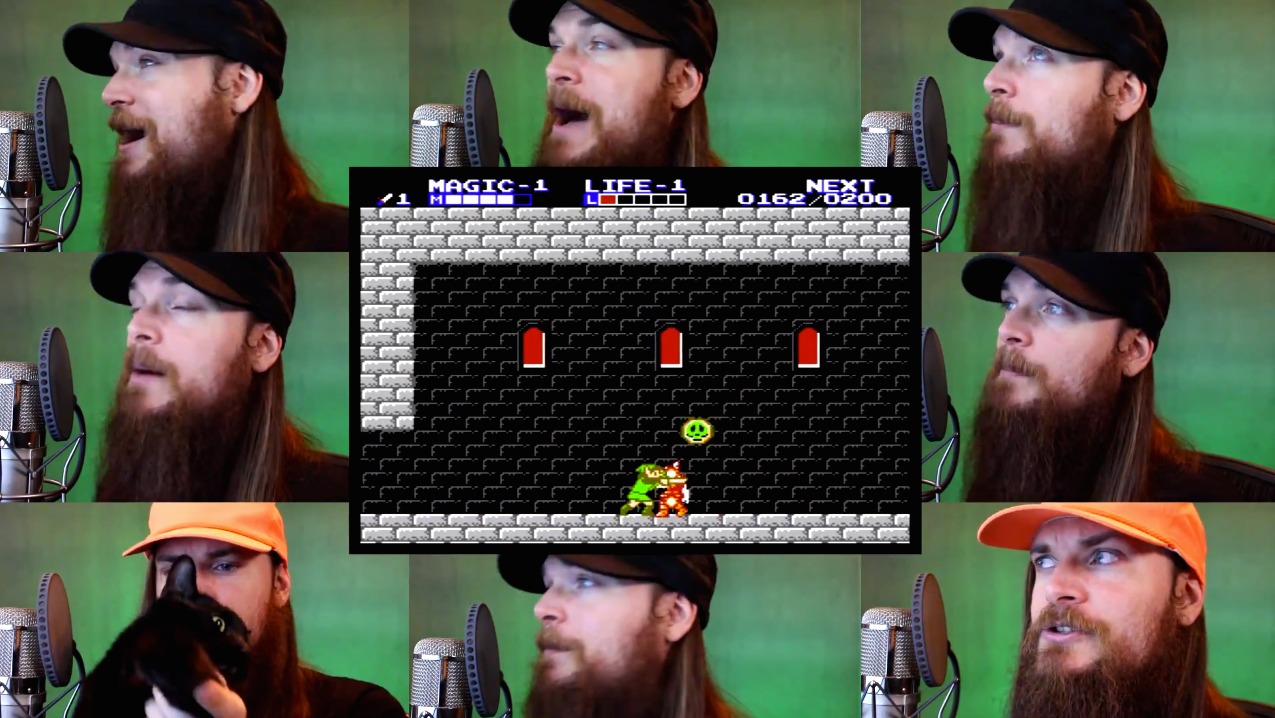Home>Instruments>Synthesizer>How To Make Synthesizer Sound Like Gary Numan


Synthesizer
How To Make Synthesizer Sound Like Gary Numan
Modified: January 22, 2024
Discover how to transform your synthesizer into a captivating instrument that emulates the iconic sound of Gary Numan. Unleash your creativity and master the art of synthesizer with our expert tips and techniques.
(Many of the links in this article redirect to a specific reviewed product. Your purchase of these products through affiliate links helps to generate commission for AudioLover.com, at no extra cost. Learn more)
Table of Contents
- Introduction
- Understanding Gary Numan’s Synth Style
- Choosing the Right Synthesizer
- Configuring the Oscillators and Waveforms
- Experimenting with Filters and Modulation
- Utilizing Effects and Distortion
- Creating Gary Numan’s Signature Lead Sounds
- Recreating Gary Numan’s Bass Synth
- Programming Synth Pads and Textures
- Adding Articulation and Expression
- Conclusion
Introduction
Gary Numan, the legendary musician and pioneer of electronic music, has left an indelible mark on the genre with his distinctive synthesizer sound. With hits like “Cars” and “Are ‘Friends’ Electric?”, Numan’s combination of melodic hooks, layered textures, and futuristic atmospheres has captivated audiences around the world. If you’re a fan of his music or simply inspired by his unique style, you may be wondering how to make a synthesizer sound like Gary Numan.
In this article, we will take a deep dive into the world of synthesizers and explore the techniques and strategies behind Numan’s iconic sound. Whether you’re a seasoned musician or a beginner in the world of electronic music, this guide will provide you with valuable insights and practical tips to help you emulate Numan’s sound and create your own distinct sonic palette.
From choosing the right synthesizer to configuring oscillators and waveform settings, from experimenting with filters and modulation to utilizing effects and distortion, we will cover everything you need to know to achieve that signature Gary Numan sound.
So, if you’re ready to unlock the secrets of Numan’s synthesizer prowess and embark on a sonic adventure, let’s dive in and discover how to make a synthesizer sound like Gary Numan.
Understanding Gary Numan’s Synth Style
Gary Numan’s synth style is characterized by its unique blend of dark, futuristic atmospheres, catchy melodies, and textured layers. His music incorporates elements of synth-pop, new wave, and industrial genres, creating a sound that is both haunting and infectious.
One of the key aspects of Numan’s synth style is his use of rich, layered textures. He often creates depth and complexity by stacking multiple synthesizers together, each playing a different part or sound. This creates a sonic landscape that is immersive and dynamic.
Another important aspect of Numan’s music is his use of atmospheric sounds and effects. He often incorporates sweeping pads, eerie drones, and pulsating rhythms, which add a sense of mystery and tension to his compositions. These atmospheric elements create a backdrop for his melodies, giving his music a distinct sense of ambiance.
Melodically, Numan’s synth style often features simple yet catchy hooks. His melodies are often based on repetitive motifs and are accompanied by rhythmic arpeggios or pulsating basslines. This combination of memorable melodies and rhythmic elements gives his music a hypnotic quality.
In terms of sound design, Numan’s synthesizers are known for their distinctive tones and timbres. He often uses thick, detuned sawtooth and square waveforms to create his signature sound. This gives his synthesizers a raw, edgy quality that cuts through the mix and grabs the listener’s attention.
Overall, Gary Numan’s synth style is a synthesis of atmospheric textures, catchy melodies, and edgy sound design. By understanding these key elements, we can begin to unravel the secrets of how to make a synthesizer sound like Gary Numan. In the next section, we will explore the process of choosing the right synthesizer to achieve his iconic sound.
Choosing the Right Synthesizer
Choosing the right synthesizer is crucial when aiming to replicate Gary Numan’s iconic sound. While there is no one-size-fits-all answer, certain synthesizers are known for their ability to achieve that classic Numan sound.
One option to consider is a vintage analog synthesizer such as the Moog Minimoog or the Roland Juno-60. These synthesizers were popular during the era of Numan’s music and can help capture the warm, fat tones that characterize his sound. Their analog circuitry and unique filter designs contribute to the richness and depth of Numan’s signature timbres.
If you prefer a more modern approach, digital synthesizers like the Access Virus or the Native Instruments Massive are worth exploring. These synths offer a wide range of customizable parameters, allowing you to create complex, evolving sounds reminiscent of Numan’s atmospheric textures.
No matter what synthesizer you choose, it’s essential to consider the features and capabilities that align with Numan’s sound. Look for synthesizers that offer a variety of waveform options, including sawtooth and square waveforms, as these are integral to Numan’s sound palette.
Additionally, pay attention to the filters and modulation capabilities of the synthesizer. Numan often used low-pass and high-pass filters to shape his sound, creating a sense of movement and dynamics. Having access to modulation options such as LFOs (Low-Frequency Oscillators) and envelopes will allow you to add the characteristic Numan touch to your sound.
Ultimately, the right synthesizer for you will depend on your personal preferences, budget, and desired sound. Experiment with different synthesizers and find the one that resonates with your creative vision. Once you have the synthesizer in hand, it’s time to dive into the world of sound design and configuration to fully capture Numan’s signature sound.
Configuring the Oscillators and Waveforms
Configuring the oscillators and waveforms is a critical step in recreating Gary Numan’s synth sound. Numan’s music often features a combination of rich, detuned waveforms that provide a unique and distinctive texture.
Start by selecting a sawtooth waveform as your foundation. Numan frequently used detuned sawtooth waves to create a thick, wide sound. Experiment by slightly detuning the oscillators to achieve that characteristic Numan timbre. This detuning contributes to the richness and depth of the sound, giving it a sense of movement and warmth.
Layering oscillators can also help you achieve a more intricate and dynamic sound. Consider adding square waveforms to complement the detuned sawtooth. This combination will enhance the edginess and complexity of the sound, contributing to Numan’s signature synthesizer style.
One way to fine-tune your sound is by experimenting with octave settings. Numan often used multiple octaves to create depth and variation in his music. Try playing with higher and lower octaves to see how they affect the overall timbre and presence of your synth sound.
When configuring the oscillator settings, it’s important to pay attention to the envelope controls. Numan’s music frequently features quick attack times, which create a sharp and punchy sound. Adjusting the attack, decay, sustain, and release parameters will allow you to shape the sound to your liking and capture the dynamic range present in Numan’s synth style.
Lastly, don’t be afraid to experiment with modulation. Numan’s synthesizers often featured subtle modulation effects added to the oscillators, such as vibrato or chorus. These effects add movement and character to the sound, giving it a distinct and ethereal quality. Explore the modulation features of your synthesizer and find the sweet spot that emulates Numan’s sonic aesthetics.
By carefully configuring your oscillators and waveforms, paying attention to detuning, layering, octave settings, envelope controls, and modulation effects, you’ll be well on your way to capturing the essence of Gary Numan’s synth sound.
Experimenting with Filters and Modulation
To truly capture the essence of Gary Numan’s synth sound, it’s essential to explore the creative possibilities offered by filters and modulation. These elements play a vital role in shaping the timbre and adding movement to your synthesizer patches.
Start by experimenting with low-pass and high-pass filters, as these are commonly used in Numan’s music. A low-pass filter will allow the lower frequencies to pass through, creating warmth and depth, while a high-pass filter will accentuate the higher frequencies, adding brightness and clarity to the sound. Adjust the cutoff frequency and resonance to find the desired balance and character in your patches.
Modulation is another key aspect of Numan’s synth style. By using modulation effects such as LFOs (Low-Frequency Oscillators), you can introduce rhythmic variations and subtle movements to your sound. Consider applying modulation to parameters such as filter cutoff, oscillator pitch, or even amplitude. This will add a dynamic and evolving quality to your patches, reminiscent of Numan’s atmospheric and futuristic soundscapes.
Experiment with different modulation waveforms and rates to achieve varying textures and rhythmic patterns. Sine and triangle waveforms tend to create smooth, flowing movements, while square and random waveforms introduce more abrupt and unpredictable modulations. Find the modulation settings that resonate with the desired mood and vibe of your Numan-inspired sound.
Additionally, don’t overlook the potential of effects in shaping your synthesizer sound. Numan’s music often featured effects such as delay, reverb, and chorus. These effects can add depth, spaciousness, and a sense of ambiance to your patches. Adjust the parameters of these effects to create the right blend and character in your sound.
Remember, the key to capturing Numan’s synth style is to experiment and push the boundaries. Don’t be afraid to think outside the box and try unconventional combinations of filters, modulation, and effects. The goal is to create a sonic palette that captures the essence of Numan’s world while adding your unique touch.
By embracing the possibilities of filters, modulation, and effects, you’ll be able to infuse your synthesizer patches with the same depth, movement, and atmosphere that make Gary Numan’s sound so iconic.
Utilizing Effects and Distortion
When striving to replicate Gary Numan’s synth sound, utilizing effects and distortion is crucial to achieving the desired sonic character. Numan’s music often featured a blend of powerful, abrasive textures combined with atmospheric elements, creating a unique sonic palette.
One commonly used effect in Numan’s music is distortion. Distortion adds grit, aggression, and intensity to your synthesizer sound. Experiment with different distortion types, such as overdrive, fuzz, or bit crushing, to find the right amount of edge and saturation for your patches. The goal is to strike a balance between a clean, punchy sound and a distorted, gritty tone that captures Numan’s signature style.
In addition to distortion, reverb is another effect that plays a significant role in achieving Numan’s atmospheric sound. By adding a touch of reverb, you can create a sense of space and depth, making your synthesizer sound more expansive and immersive. Experiment with different reverb types, such as hall, plate, or spring, and adjust the decay time and pre-delay to achieve the desired ambiance.
Delay is another effect that can enhance your synthesizer sound by introducing rhythmic echoes and repeats. Numan often used delay to create a sense of movement and anticipation in his music. Experiment with different delay times, feedback levels, and stereo spread to add a sense of dimension and liveliness to your patches.
To further enhance the sonic impact of your synthesizer sound, consider utilizing modulation effects such as chorus or flanger. These effects can add a sense of motion and depth to your patches, making them more dynamic and expressive. Experiment with different modulation settings and intensity levels to find the sweet spot that captures the essence of Numan’s atmospheric textures.
Remember, the key to using effects and distortion is to strike a balance that complements the overall sound of your synthesizer patches. It’s important to avoid overusing effects, as this can lead to a muddled and cluttered sound. Aim for a cohesive blend of distortion, reverb, delay, and modulation that enhances the sonic character of your patches without overpowering them.
By utilizing effects and distortion in a thoughtful and intentional manner, you can add the final layer of texture and atmosphere to your synthesizer sound, capturing the essence of Gary Numan’s iconic style.
Creating Gary Numan’s Signature Lead Sounds
Gary Numan’s synth sound is synonymous with his unforgettable lead melodies that cut through the mix and captivate listeners. To recreate his signature lead sounds, we need to focus on a combination of sound design techniques and expressive playing.
Start by selecting a lead synthesizer patch with a powerful, bright, and cutting tone. A combination of sawtooth and square waveforms is often used to achieve this distinctive sound. Experiment with different envelope settings to create a sharp attack that gives your lead sound a punchy and immediate presence.
Utilize the filter envelope to shape the lead sound further. Numan often employed a quick decay and subtle modulation of the filter cutoff to add expressive movement and character to his leads. By experimenting with the filter envelope settings, you can infuse your lead sounds with the same emotive qualities that define Numan’s music.
Add a touch of chorus or other modulation effects to lend depth and width to your lead sound. Numan’s lead melodies often had a spacious and expansive quality to them. Carefully apply modulation effects to create a sense of movement and richness that helps your lead melodies soar.
Another important aspect of Numan’s lead sound is the use of expressive techniques while playing. Incorporate techniques such as pitch bends, vibrato, and glides to bring life and emotion to your lead melodies. Numan’s ability to convey a sense of urgency and drama through his playing style is what makes his lead sounds so memorable.
Experiment with the range of your playing by exploring different octaves and intervals. Numan often played lead melodies that spanned a wide range, creating a sense of drama and tension. By utilizing different octaves and intervals in your lead melodies, you can achieve a similar effect.
Finally, don’t be afraid to add a touch of distortion or saturation to your lead sounds. Numan’s lead melodies often had a raw and edgy quality to them. Lightly applying distortion or saturation can add grit and intensity to your lead sound, helping it cut through the mix and command attention.
Overall, recreating Gary Numan’s signature lead sounds involves a combination of thoughtful sound design, expressive playing techniques, and attention to detail. By focusing on creating a powerful tone, utilizing the filter and modulation effects, and incorporating expressive techniques in your playing, you can capture the essence of Numan’s lead sound and create melodies that leave a lasting impression.
Recreating Gary Numan’s Bass Synth
Gary Numan’s bass synth sound is a crucial element of his music, providing a solid foundation and driving force to his compositions. To recreate his iconic bass sound, we need to focus on specific sound design techniques and attention to detail.
Start by selecting a synthesizer patch that has a rich, deep, and full-bodied tone. Numan’s basslines often had a significant presence in the mix, and a powerful sound is key to achieving this. Consider using a combination of oscillator waveforms such as sawtooth or square to create a strong and punchy bass sound.
Setting the filter cutoff is essential in shaping the character of Numan’s bass sound. Experiment with low-pass filters and find the cutoff frequency that gives the bass a warm, yet defined tone. Adjust the resonance to add a touch of bite and presence to the sound, and consider using envelope modulation to create dynamic filter movement.
Pay attention to the envelope settings to create a tight and punchy bass sound. Numan’s basslines often had quick attack times and short decay times to emphasize the rhythmic drive. Adjust the sustain level to maintain a consistent volume, and control the decay to shape the length of each note.
Consider incorporating modulation effects such as chorus or flanger to add depth and movement to your bass sound. Numan often utilized subtle modulation effects to create a sense of motion and liveliness in his basslines. Experiment with different modulation settings and intensity levels to find the right balance.
To capture the distinctive character of Numan’s bass sound, it’s important to focus on the playing technique as well. Numan’s basslines were often characterized by a rhythmic and determined playing style. Play with precision, emphasizing the attack and release of each note to enhance the groove and impact of your basslines.
Lastly, don’t forget to pay attention to the overall mix and EQ of your bass sound. Numan’s bass was typically prominent in the mix and had a clean and defined presence. Adjust the EQ to cut through the mix without overpowering other elements, and ensure that the bass sits well with the drums and other instruments.
By combining meticulous sound design, attention to detail, expressive playing, and careful mixing, you can recreate Gary Numan’s distinctive bass synth sound. Emphasize the deep, powerful tone, shape the sound with filters and modulation, and play with precision and rhythmic intent to capture the essence of Numan’s basslines.
Programming Synth Pads and Textures
In addition to his signature lead sounds and basslines, Gary Numan’s music is also known for its atmospheric synth pads and textures. These elements create a sense of depth, ambiance, and ethereal atmosphere in his compositions. To program synth pads and textures reminiscent of Numan’s style, attention to sound design and layering is key.
Start by selecting a synthesizer patch with a rich, sustained sound. Synthesizers with capabilities for generating lush pads, such as those with multiple oscillators, extensive modulation options, and built-in effects, are ideal for creating textured pads. Experiment with different waveform combinations, such as blending sawtooth and sine waves, to achieve a full-bodied and immersive sound.
Layering is an essential technique in creating complex and evolving synth pads. Combine multiple instances of the synthesizer, each with slightly different settings, to add depth and dimension to your pads. Experiment with detuned oscillators, different filter settings, and subtle modulations to create a rich, evolving soundscape.
Envelopes play a crucial role in shaping the characteristics of pads and textures. Consider using longer attack times and release times to create gradual swells and fades that contribute to the atmospheric quality. Experiment with the sustain level to fine-tune the ongoing presence of your pads.
Effects are instrumental in enhancing the depth and atmosphere of your synth pads. Modulation effects such as chorus, phaser, and flanger can add movement and richness to your sound. Reverb can be used to create a sense of space and immersion, while delay can introduce echoes and create an enveloping soundscape. Fine-tune the settings of these effects to achieve the desired result.
When programming synth pads and textures, it’s important to take a holistic approach to your sound. Consider how the pads fit within the context of your composition and complement other elements. EQ and panning can help ensure that the pad sounds sit well in the mix and provide a wide stereo field.
To imbue your pads with Numan’s unique touch, don’t be afraid to experiment and push boundaries. Explore unconventional waveform combinations, experiment with modulation parameters, and create evolving, otherworldly textures that capture the otherworldly essence of Numan’s music.
By utilizing sound design techniques, layering, effects, and a touch of experimentation, you can program synth pads and textures that transport listeners to the atmospheric realms of Gary Numan’s soundscapes.
Adding Articulation and Expression
One of the defining characteristics of Gary Numan’s synth sound is the level of articulation and expression he brings to his performances. Adding these elements to your own synthesizer playing will allow you to capture the essence and emotive qualities of his music.
Start by focusing on the playing technique. Numan’s playing style often features precise and deliberate attacks on the keys, creating a rhythmic and percussive quality. Pay attention to the dynamics of your playing, emphasizing the accents and giving each note a distinct punch or release.
Utilize techniques such as pitch bends, vibrato, and glides to add expressiveness to your playing. These techniques can elevate the emotional impact of your synth melodies, allowing you to recreate the same sense of urgency and drama that can be found in Numan’s performances.
Experiment with different velocity settings on your synthesizer. Varying the velocity with which you strike the keys can add natural variations in volume and intensity, adding a human-like touch to your playing. This can help recreate the organic and nuanced qualities found in Numan’s music.
Take advantage of the modulation wheel or other assignable controllers on your synthesizer to introduce real-time changes in parameters such as filter cutoff, resonance, or modulation depth. This allows you to shape the sound on the fly, infusing your playing with dynamic variations that mimic the expressiveness of Numan’s performances.
Furthermore, exploring the range of your synthesizer’s capabilities can enhance the articulation and expression of your playing. Experiment with different octaves, intervals, and chord progressions to bring variety and depth to your melodies. Don’t be afraid to step outside of traditional scales and explore dissonance or unconventional combinations to add an edgy and impactful quality to your synth lines.
Finally, as with any instrument, practice and familiarity with your synthesizer are essential. Spend time developing muscle memory and getting to know the nuances and capabilities of your specific instrument. This will allow you to execute the desired articulations and expressions with precision and confidence.
By adding articulation and expression to your synthesizer playing, you can capture the essence of Gary Numan’s emotive style. Focus on precise attacks, incorporate techniques like pitch bends and vibrato, experiment with velocity variations and modulation, and master the range of your instrument. By doing so, you’ll infuse your performances with the same level of passion and intensity that define Numan’s music.
Conclusion
Recreating Gary Numan’s iconic synth sound is a thrilling journey into the world of sound design, expression, and musical exploration. By understanding the elements that define his unique style and employing various techniques, you can capture the essence of his music and create your own sonic tapestry.
From choosing the right synthesizer to configuring oscillators and waveforms, experimenting with filters and modulation, utilizing effects and distortion, and crafting lead sounds, bass synths, pads, and textures, each step brings you closer to emulating Numan’s distinctive sound.
Articulation and expression are also of paramount importance, as they allow you to infuse your playing with the same dynamism and emotive qualities that make Numan’s music so captivating. Through precision, techniques like pitch bending and vibrato, and exploration of your synthesizer’s range, you can bring your compositions to life with a palpable sense of urgency and drama.
Remember, while this guide provides a framework for recreating Numan’s sound, it’s also important to infuse your own creativity and individuality into your music. Numan’s sound was forged through experimentation and pushing boundaries, so don’t hesitate to explore new techniques, sound combinations, and expressive possibilities.
By taking the time to understand Numan’s synth style and integrating the techniques described in this guide, you can unlock new sonic horizons and forge a unique musical identity that pays homage to Gary Numan while leaving your distinct mark on the world of electronic music.
So, grab your synthesizer, experiment, and let the spirit of Gary Numan guide you as you embark on your sonic journey. The possibilities are endless, and the thrill of creating your own unique sound awaits.











